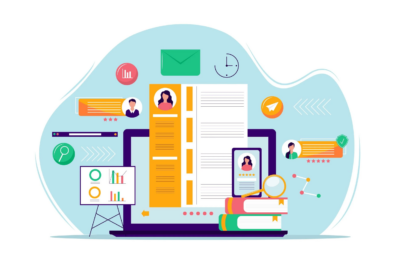Human Resources (HR) plays a crucial role in any organization. It is responsible for managing the most valuable asset of a company – its employees.
HR processes are essential for recruiting, hiring, onboarding, training, and managing employees throughout their organisational tenure.
However, these processes can often be time-consuming and inefficient, leading to wasted resources and decreased productivity. Streamlining HR processes is crucial for organizations to operate smoothly and effectively with HR management software.
There are several benefits to streamlining HR processes.
Firstly, it saves time and reduces administrative burden. By automating repetitive tasks and eliminating manual paperwork, HR professionals can focus on more strategic initiatives that add value to the organization.
Secondly, streamlining HR processes improves accuracy and reduces errors.
By implementing standardized procedures and utilizing technology, the chances of mistakes are minimized. This leads to better decision-making and improved employee satisfaction.
Lastly, streamlining HR processes enhances compliance with labour laws and regulations.
By ensuring that all HR practices are in line with legal requirements, organisations can avoid costly penalties and lawsuits.
Understanding Employee Personnel Files: What They Contain and Why They're Important

A personnel file is a comprehensive record of an employee’s employment history with an organisation. It contains various documents and information related to the employee’s hiring, performance, compensation, benefits, and any disciplinary actions or grievances. Personnel files are important for both HR professionals and the organization as a whole.
Personnel files serve as a centralized repository of information about employees. They provide a complete picture of an employee’s journey within the organization, making it easier for HR professionals to track their progress and make informed decisions regarding promotions, transfers, or terminations.
Personnel files also play a crucial role in legal compliance. They contain important documents such as employment contracts, tax forms, performance evaluations, and disciplinary records that may be required in case of audits or legal disputes.
Assessing Your Current HR Processes: Identifying Areas for Improvement

To streamline HR processes, it is essential to conduct an audit of the current processes and identify areas for improvement. This can be done by reviewing existing procedures, gathering feedback from HR staff and employees, and analyzing data related to HR operations.
During the audit, it is important to evaluate the efficiency and effectiveness of each HR process. Look for bottlenecks, redundancies, and areas where manual intervention can be reduced or eliminated. Identify any gaps in compliance with labour laws and regulations. Assess the accuracy and completeness of personnel files and other HR documentation.
Once the audit is complete, set goals for streamlining HR processes. These goals should be specific, measurable, achievable, relevant, and time-bound (SMART).
For example, a goal could be to reduce the time taken to process employee onboarding by 50% within six months. By setting clear goals, it becomes easier to track progress and measure the success of the streamlining efforts.
Digital vs. Physical Personnel Files: Pros and Cons of Each Approach

One of the key decisions in streamlining HR processes is choosing between digital or physical personnel files. Both approaches have their advantages and disadvantages.
Digital personnel files offer several benefits. They are easily accessible from anywhere with an internet connection, making it convenient for HR professionals to retrieve and update information. Digital files also take up less physical space compared to physical files, reducing storage costs. Additionally, digital files can be easily backed up and protected from loss or damage.
However, there are also disadvantages to digital personnel files. They require an initial investment in technology infrastructure and software. There may also be concerns about data security and privacy. Furthermore, not all employees may be comfortable with digital files or have access to the necessary technology.
On the other hand, physical personnel files have their own advantages. They do not require any technological infrastructure or software investment. They are also familiar to most employees and may be preferred by those who are not comfortable with digital files. However, physical files can take up a significant amount of physical space and may be prone to loss or damage.
When choosing the right approach for your organization, consider factors such as the size of your workforce, the availability of technology infrastructure, and the preferences of your employees. It may also be possible to adopt a hybrid approach, where some documents are stored digitally while others are kept in physical form.
Implementing a Document Management System: Best Practices and Considerations
A document management system (DMS) is a software solution that helps organizations store, manage, and track their documents electronically. Implementing a DMS can greatly streamline HR processes by providing a centralized platform for storing and accessing personnel files and other HR documents.
When implementing a DMS, it is important to follow best practices to ensure its success. Firstly, clearly define the objectives and scope of the DMS implementation. Identify the specific HR processes that will be automated or improved through the DMS. Secondly, involve key stakeholders from HR, IT, and other relevant departments in the decision-making process. Their input and buy-in are crucial for successful implementation.
Considerations when choosing a DMS include scalability, ease of use, integration with existing systems, data security features, and vendor support. It is important to select a DMS that aligns with the organization’s needs and requirements.
Crown has a full suite of software and solutions to cater to different needs with our solution for Enterprise.
Once the DMS is implemented, provide training to HR staff on how to use the system effectively. This will ensure that they are able to handle and store personnel files properly within the DMS.
Ensuring Compliance: Staying Up-to-Date with Labor Laws and Regulations
Compliance with labour laws and regulations is crucial for HR processes. Failure to comply can result in legal consequences, financial penalties, damage to reputation, and loss of employee trust. Therefore, it is important for HR professionals to stay up-to-date with the latest labour laws and regulations.
To ensure compliance, HR professionals should regularly review and update their knowledge of labour laws and regulations. This can be done through attending seminars, webinars, and workshops, subscribing to industry publications, and networking with other HR professionals. It is also important to establish a system for tracking changes in labour laws and regulations and communicating them to relevant stakeholders within the organization.
Additionally, HR professionals should regularly review and update HR policies and procedures to ensure they are in line with current labour laws and regulations. This includes updating employee handbooks, employment contracts, and other relevant documents.
Streamlining Onboarding and Offboarding Processes: Tips for Efficiently Managing Employee Transitions
Efficient onboarding and offboarding processes are crucial for a smooth employee transition. Streamlining these processes can greatly improve the employee experience and save time for HR professionals.
To streamline employee onboarding processes, consider automating tasks such as sending welcome emails, collecting new hire paperwork electronically, and providing online training modules. Utilize technology to create a centralized onboarding portal where new hires can access all necessary information and complete required tasks.
Similarly, offboarding processes can be streamlined by automating tasks such as collecting exit interviews, updating employee records, and conducting exit surveys. Develop a checklist or workflow that outlines all the necessary steps to be taken during the offboarding process.
It is also important to provide clear communication to both new hires and departing employees about the onboarding and offboarding processes. This includes providing them with all necessary information, setting expectations, and answering any questions they may have.
Developing Standard Operating Procedures: Creating Consistency and Reducing Errors

Standard operating procedures (SOPs) are step-by-step instructions that outline how specific tasks should be performed within an organization. Developing SOPs for HR processes can greatly streamline operations by creating consistency and reducing errors.
To develop SOPs, start by identifying the key HR processes that need standardization. This could include processes such as employee onboarding, performance evaluations, leave management, and disciplinary actions.
Break down each process into individual steps and document them clearly and concisely.
When developing SOPs, involve key stakeholders from HR and other relevant departments. Their input and expertise will ensure that the SOPs are comprehensive and effective. It is also important to regularly review and update SOPs to reflect any changes in processes or regulations.
The benefits of creating consistency and reducing errors in HR processes include improved efficiency, increased productivity, enhanced employee satisfaction, and reduced risk of legal non-compliance.
Grab our comprehensive employee personnel file checklist for your reference or as a starting guide.
Training HR Staff: Ensuring Proper Handling and Storage of Personnel Files

Proper training of HR staff is crucial for ensuring the efficient handling and storage of personnel files. Training should cover topics such as data privacy, confidentiality, recordkeeping requirements, and best practices for handling sensitive information.
Training can be conducted through a combination of in-person sessions, online courses, workshops, and job shadowing. It is important to provide ongoing training to keep HR staff updated on any changes in regulations or procedures.
In addition to training, it is important to establish clear policies and procedures for handling and storing personnel files. This includes guidelines for access control, data security measures, retention periods, managing employee file requests, and disposal procedures.
Regular audits should be conducted to ensure compliance with these policies and procedures. This includes reviewing access logs, conducting physical inspections of file storage areas, and verifying the accuracy and completeness of personnel files.
The Benefits of Streamlining HR Processes and Tips for Getting Started
In conclusion, streamlining HR processes is essential for organizations to operate efficiently and effectively.
By automating repetitive tasks, improving accuracy, ensuring compliance with labour laws and regulations, and creating standardized procedures, HR professionals can save time, reduce errors, enhance employee satisfaction, and mitigate legal risks.
To get started with streamlining HR processes, it is important to assess the current processes, identify areas for improvement, and set goals for streamlining efforts.
Consider implementing a document management system to centralize HR documentation and improve accessibility.
Stay up to date with labour laws and regulations to ensure compliance. Streamline onboarding and offboarding processes to improve employee transitions. Develop standard operating procedures to create consistency and reduce errors.
Finally, provide proper training to HR staff on handling and storing personnel files.
By implementing these strategies, organizations can streamline their HR processes and reap the benefits of increased efficiency, improved accuracy, and enhanced compliance.










